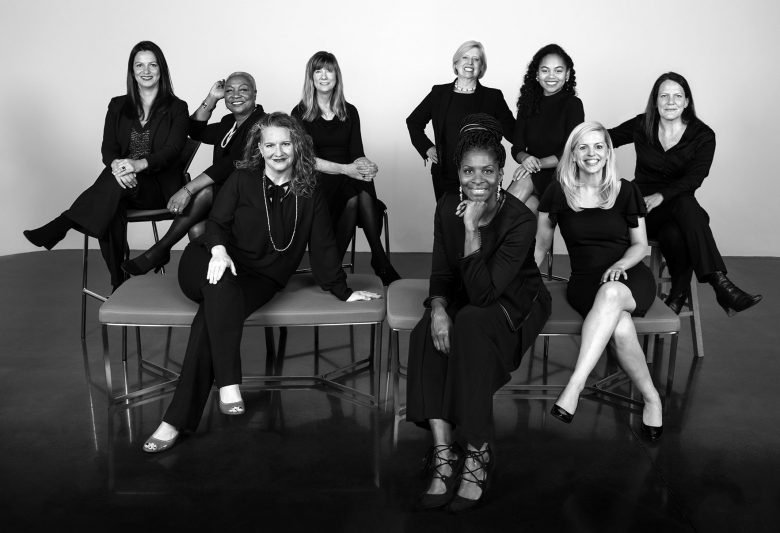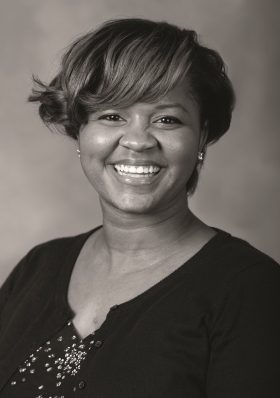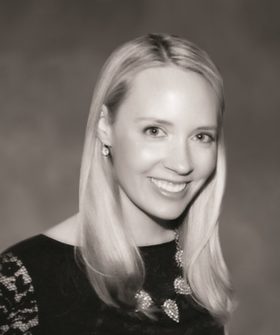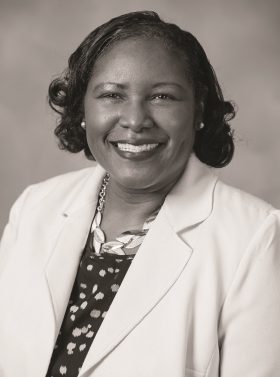Despite challenges, more women are making their mark in leadership roles at Elon and beyond.

When Kerrii Anderson ’79 was growing up on a tobacco farm about five miles outside of Elon, she never thought of any job as being strictly for one gender. She drove a tractor on the farm, where most of the workers were men with the exception of her sister.
At age 16, she started driving a school bus. “I guess because I grew up that way, there was no mindset that I could not do something because I was female,” Anderson says. “But when I got out into the world and began working in public accounting, there was no doubt in my mind that because I was female, I had to work harder, I had to be smarter and I must be better prepared.”
Fast forward 40 years and Anderson has held many prominent leadership positions in the business world, including stints as chief financial officer and chief executive officer of Wendy’s International. She now sits on the boards of Abercrombie & Fitch, LabCorp and Worthington Industries, as well as Elon University’s board of trustees, which she previously chaired.
While women have steadily made more strides toward increased leadership opportunities throughout history, it’s only within the past year or so that the national conversation surrounding women’s equality in business, government, education and other arenas has grown louder and stronger. The #MeToo and Time’s Up movements have empowered women to speak up about sexual assault and harassment and engage in more open dialogue about gender equality in the workplace. In September 2018, California enacted a law requiring the state’s publicly traded companies to include at least one woman on their boards of directors by the end of 2019. Similar measures already exist in some European countries such as Belgium, France, Italy and Norway. Many news outlets dubbed 2018 a “Year of the Woman,” with more women elected to Congress than ever before, including the first Native American and Muslim women representatives. Still, those record 127 women only equate to 24 percent of Congress, a long way from true gender parity.

Leigh-Anne Royster, director of inclusive community development and assistant professor, says if organizations learn to truly value the unique viewpoints that a diverse group of leaders brings to the table, it creates a more multifaceted professional environment. You can become immersed in understanding and you can develop an amazing sense of empathy around all sorts of identities, she says, but there is no substitution for actually living out those identities. “There is nothing like having organized one’s entire life around being a woman, being gender nonconforming or being Latina, for example. You bring that perspective,” she says.
While women are connected by gender, Associate Professor of English Prudence Layne emphasizes women embody a host of other identities too, from ideology to cultural background. It’s important not only for all of those voices to have an opportunity to speak, she says, but for others to really listen to those perspectives so the culture of leadership can change. “When you think about women of color, I am still largely not represented at Elon, but that has not stopped me from looking to see where the needs are and doing what I can to fulfill those, not just for faculty but for staff and students,” Layne says. “What makes me happy is Elon is actually working in the classroom to help others build their own confidence and be empowered.”
Elon’s leadership has certainly shifted since Anderson was a student, when few women held high-ranking management positions at the university. Four of the six academic deans are now women—Ann Bullock (School of Education), Rochelle Ford (School of Communications), Becky Neiduski (School of Health Sciences) and Gabie Smith (College of Arts and Sciences). The chairs of Academic Council and Staff Advisory Council are also women—Layne and Manager of Phoenix Card Services Janet Rauhe, respectively—and more women occupy director positions among the university’s staff than ever before.
And of course, President Connie Ledoux Book became the first female president in Elon’s history in 2018, a milestone that was embraced in the news surrounding her selection and inauguration. “It was a search committee decision and a unanimous decision to select Connie, and I was so proud of how widely we cast our net,” Anderson says. “We were very focused on having a diverse slate of candidates. When the decision was made, we selected the best candidate, not the best female candidate. Having said that, I’m really proud that she’s female. She earned it.”
An ongoing climb
Elon’s history of women’s inclusion dates back to its founding as a co-educational institution in 1889 at a time when women’s educational opportunities were still limited. But like many other colleges and universities, most leadership positions were predominantly held by men for decades. When Jo Watts Williams ’55 was a student, she says the societal expectation was that if women wanted to work outside the home, they would pursue one of two career paths: nursing or teaching. She opted for the latter and after serving as a public school teacher for 14 years, she returned to Elon as a faculty member in what was then the Department of Education and Psychology.
The next step in her career was unexpected, when in 1976 President J. Fred Young and the board of trustees asked her to move into an administrative role as associate dean of academic affairs and director of the learning resource center. Williams ultimately rose to vice president of development in 1979 and right away made her own strides toward changing the higher education landscape not only through her own work, but by hiring and supporting other women in administrative leadership roles at Elon. “I used my energy trying to bring in capable women to serve in roles,” Williams says. “I started hiring women and just kept bringing them in. I quietly and patiently kept plugging away.”

In general, Klopman thinks women ultimately made inroads in their professional lives out of financial necessity. As the cost of living in some areas of the United States began to climb, more women entered the workforce because their households needed more than one income to thrive. “I’m 70 now, so it was not until maybe 20 years ago that I really began to see this change,” Klopman says. “Women absolutely rose to the occasion. The responsibilities women handled managing a household were always overlooked as a strength until it became the necessity of economics. I think women have had a tough climb within organizations because we were not positioned by experience or education to all of a sudden infiltrate the ranks of upper-level management.” As she watched Elon grow during her tenure, Klopman saw more and more women move from leading behind the scenes to leading in management roles, ultimately including the university’s highest office.
“It took 129 years, but we got there,” Williams says. “You can’t imagine how fulfilling it is to look back when there were no women in any of those roles before.”

While many think of leaders as high-profile people who everyone knows, Class of 2022 President Lauryn Adams admires the “hidden figures” who work behind the scenes or in pockets of society that are often ignored. “I’m one of the few black people in the dance program at Elon, and I think that in itself is a form of leadership, paving the way for other black students who want to be dance majors,” she says. “I’m also able to show up in my American government class and speak up for certain things that someone else isn’t in the room to say or advocate for.”
Adams also believes it’s crucial for women in leadership to support one another. During a meeting for prospective Student Government Association candidates, when Adams mentioned her intention to run for class president to another young woman in attendance, the student replied she was considering president too but would run for vice president instead. “That was very telling to me, that as women we see each other as competition when there is space for all of us,” Adams says. “Sometimes we put ourselves down before even giving ourselves the chance to be successful.”
Creating a climate for success
Royster has always been impressed that Elon strikes a balance between investing in the development of inclusion and equity in authentic ways while being open and honest about the work that still needs to be done. She routinely sees students engaging in conversations about equity in their daily lives, from expanding on discussions that start in the classroom to unpacking how gender issues tie into the songs they listen to and the movies they see.

The challenge now is continuing that work during what Royster says is both an exciting and scary time for gender equality in the United States. She now sees more harmful rhetoric directed toward women and girls than at any point in recent history, but she also sees more transparency and agency among women. They are leading by talking openly about gender discrimination, from growing grassroots movements to more celebrities using their platform to elevate the voices of those with less power. Bullock says that work is essential to challenging antiquated perspectives about leadership and helping others understand the validity of women’s voices in spaces where some feel they don’t belong. “We need to work collectively to change mindsets on what has been deemed ‘the norm’ so we can continue to make waves and not just have a seat at the table but build tables that are more inclusive and diverse,” she adds.
The more students see women leading by example on campus, Bullock says, the more they will feel empowered to effect change in the world at large after they graduate. Gabrielle Raymond McGee ’06 is among the alumni who are blazing trails for women in leadership. She is chief operating officer at the Tory Burch Foundation, which provides access to capital, education and digital resources for women entrepreneurs. One of the foundation’s core initiatives is #EmbraceAmbition, which addresses the stigma that ambition is a negative characteristic for women but a positive quality for men. “By challenging the way men and women alike perceive women that are ambitious, and empowering women and girls to fearlessly pursue their dreams, we will make the playing field more even for women to achieve parity and take on critical roles as leaders” she says.

In the political sphere, Eaves hopes to see more women in leadership at all levels of government and across party lines. Eaves says one of the most concerning statistics from the midterm elections is that while women made gains overall, the number of Republican women serving in Congress actually declined. Only 13 Republican women now serve in the House of Representatives, down from 23 the previous term. If the U.S. Congress can ever come close to reaching gender parity, Eaves says it is critical for both parties to empower women to run for office. While most media attention has been focused on the congressional midterm elections, more women also ran for governor, mayor, city council, school boards and other state and local offices. “The ultimate goal would be that one day we don’t have these stories,” Eaves says. “We don’t have to call it a ‘Year of the Woman;’ it’s just not a big deal. We’re not close to that yet, but we are making gains.”
Royster says it is essential for organizations to create environments where different styles of leadership can flourish. If a single parent holds a leadership position, for example, their employer should consider how to structure work in a way that best equips that person to succeed. If a company wants socioeconomic diversity, it’s crucial to consider how those employees organize their lives around transportation, second jobs or other realities. “If we have constructed leadership historically around one identity—white, male, cisgender, wealthy, able-bodied—and we want diversity of identity in leadership, then we need to think about what it means to create the environment where diversity can exist.”

Though Royster acknowledges some of the national discourse surrounding women’s rights today is discouraging, she says there are also plenty of reasons to be encouraged. At Elon she sees students and colleagues speaking out not only about women’s equality in general but about issues that are unique to women of color, for example. She hopes those conversations will continue to grow louder on a national scale. “Instead of an arc of justice, I think about work toward equity and inclusion as this tide that eventually erodes the shore,” Royster says. “It recedes at times, and I think we’re seeing a little bit of that tension right now, but it’s encouraging that we have the waves and swells.”


